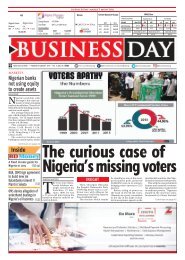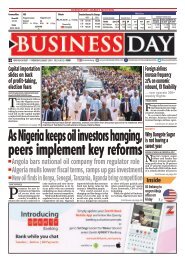BusinessDay 25 Oct 2017
You also want an ePaper? Increase the reach of your titles
YUMPU automatically turns print PDFs into web optimized ePapers that Google loves.
Wednesday <strong>25</strong> <strong>Oct</strong>ober <strong>2017</strong><br />
marketinsight<br />
Heightened risk appetite<br />
props up oil prices<br />
Oil rebounded<br />
as a risk-on<br />
appetite is<br />
seen coming<br />
back into financial<br />
markets.<br />
West Texas Intermediate<br />
futures closed 0.4 percent<br />
higher in New York as<br />
US equities rallied. In the<br />
US, oil rigs slid for a third<br />
week, according to Baker<br />
Hughes data. Meanwhile,<br />
supply from Kurdistan<br />
remains uncertain. WTI’s<br />
50-day moving average<br />
rose above the 200-day<br />
one, a bullish signal know<br />
as a golden cross.<br />
West Texas Intermediate<br />
crude for November<br />
delivery, rose 18 cents to<br />
settle at $51.47 a barrel on<br />
the New York Mercantile<br />
Exchange. Total volume<br />
was about 23 percent below<br />
the 100-day average.<br />
The more-actively traded<br />
December contract added<br />
33 cents to end the session<br />
at $51.84.<br />
Brent for December<br />
settlement climbed 52<br />
cents to settle at $57.75<br />
a barrel on the Londonbased<br />
ICE Futures Europe<br />
exchange. The global<br />
benchmark crude traded<br />
at a premium of $5.91 to<br />
December WTI.<br />
“The risk-on appetite is<br />
coming back. The general<br />
rhetoric has been OPEC<br />
is going to be extending<br />
their cuts. We have been<br />
seeing good demand in<br />
the US. At the end of the<br />
day, the market is shaping<br />
up a lot more firmly than<br />
most were anticipating.”<br />
Michael Loewen, a com-<br />
modities strategist at Scotiabank<br />
in Toronto, said.<br />
OPEC is seen willing<br />
to extend its deal to<br />
reduce output, with the<br />
Russian President Vladimir<br />
Putin saying if OPEC<br />
and allies did agree to an<br />
extension, it should run<br />
through at least the end<br />
of next year.<br />
Geopolitical tensions<br />
in Iraq have helped to<br />
support oil prices this<br />
week. Goldman Sachs<br />
Group Inc. said the potential<br />
impact of tensions<br />
in the Middle East<br />
is uncertain. The flow rate<br />
through the pipeline connecting<br />
Kurdistan to the<br />
Turkish port of Ceyhan<br />
remained below normal<br />
rates, at about 200,000<br />
barrels a day, according to<br />
a port agent. Iraqi forces<br />
regained control on Zummar<br />
town where Batma<br />
and Ain Zala fields are<br />
located, the Iraq military<br />
said in a statement.<br />
Asian LNG market to get $10 billion push from Japan<br />
Asian LNG market<br />
is set to receive a<br />
$10 billion public-private<br />
push<br />
from Japan, the world’s<br />
largest importer of liquefied<br />
natural gas.<br />
Japanese minister of<br />
economy, trade and industry,<br />
Hiroshige Seko<br />
was reported as saying<br />
the Japanese initiative<br />
will financially support<br />
projects boosting supplies<br />
to Asia or creating<br />
additional LNG demand<br />
in the region in order to<br />
absorb the global rise in<br />
supply.<br />
Japanese ministry of<br />
economy, trade and industry<br />
(METI) will be at<br />
the forefront of the initiative<br />
providing training to<br />
both consumer and producer<br />
personnel over the<br />
coming five years.<br />
Speaking at an LNG<br />
conference in Tokyo, Seko<br />
urged the Asian countries<br />
to increase the use of natural<br />
gas as a fuel source.<br />
In addition to creating<br />
demand, METI is looking<br />
to push for greater LNG<br />
market liquidity as well<br />
as the abolition of destination<br />
clauses that have<br />
been ruled as anti-competitive<br />
by the Japanese<br />
Fair Trade Commision.<br />
Japan signed a deal<br />
with India, setting the<br />
stage for collaboration on<br />
creating a liquid, flexible<br />
and global LNG market,<br />
as well as the abolition of<br />
destination clauses.<br />
C002D5556<br />
BUSINESS DAY<br />
07<br />
WEST AFRICA ENERGY<br />
OPEC Flakes<br />
OPEC seeks to institutionalize<br />
partnership with non-OPEC<br />
OPEC aims to<br />
discuss making<br />
permanent its<br />
coalition with<br />
10 and possibly more<br />
non-OPEC producers to<br />
manage oil market balances<br />
at its November 30<br />
meeting, the organization’s<br />
secretary general,<br />
Mohammed Barkindo<br />
said.<br />
“This platform of 24<br />
countries, now hopefully<br />
growing, should be institutionalized,”<br />
Barkindo<br />
said. “We should have a<br />
permanent framework to<br />
sustain this platform.”<br />
Barkindo said the pro-<br />
The current<br />
OPEC/non-<br />
OPEC output cut<br />
deal is starting to<br />
bring the global oil market<br />
back towards balance,<br />
but the agreement will<br />
likely need to run until at<br />
least the end of next year<br />
to fully draw down the<br />
overhang of oil stocks, Total<br />
CEO Patrick Pouyanne<br />
said.<br />
“The OPEC/Non-<br />
OPEC deal is working<br />
well. I think the market<br />
is slowly rebalancing,<br />
the inventories are going<br />
down,” Pouyanne said.<br />
Pouyanne said, however,<br />
he would reiterate<br />
comments he made in<br />
January when the OPEC<br />
cuts began, that it would<br />
take at least two years for<br />
the cut deal to fully rebalance<br />
the oil market and<br />
reduce the overhang of<br />
global oil stocks.<br />
“If you have three or<br />
posal to formalize cooperation<br />
with non-OPEC<br />
countries should “give<br />
comfort” to some currently<br />
non-participating<br />
countries, an apparent<br />
reference to efforts to get<br />
more countries to join the<br />
cuts.<br />
OPEC late last year<br />
agreed with 10 non-<br />
OPEC countries, led by<br />
Russia, to cut a combined<br />
1.8 million b/d in supplies<br />
to support the markets’<br />
rebalancing.<br />
Asked about projections<br />
by the IEA of oversupply<br />
in the first quarter<br />
of 2018 and how that<br />
would play into discussions<br />
about renewing<br />
supply cuts which expire<br />
at the end of March, Barkindo<br />
cast doubt on the<br />
projections.<br />
“For us the projections<br />
for 2018 remain robust.<br />
We are looking at growth<br />
of about 1.4 million b/d”<br />
for the year.<br />
OPEC oil output cuts ‘working’<br />
but need to run to end-2018<br />
four years of oversupply,<br />
it takes time to rebalance<br />
the market,” he said.<br />
According to the IEA’s<br />
latest monthly oil market<br />
report, OECD oil stocks<br />
continued falling against<br />
the five-year average<br />
in August, to reach 170<br />
million barrels above<br />
the five-year average,<br />
although the total remained<br />
above the 3 billion<br />
mark, at 3.015 billion<br />
barrels.


















